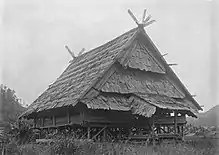Lake Poso
Lake Poso (Indonesian: Danau Poso) is a lake in Central Sulawesi, Indonesia, and the third-deepest lake in Indonesia.
| Lake Poso | |
|---|---|
 Lake Poso  Lake Poso | |
| Location | Central Sulawesi, Indonesia |
| Coordinates | 1°55′28″S 120°37′0″E |
| Type | Tectonic |
| Primary outflows | Poso River |
| Basin countries | Indonesia |
| Surface area | 323.2 km2 (124.8 sq mi) |
| Max. depth | 450 m (1,480 ft) |
| Water volume | 216 gigalitres (175,000 acre⋅ft) |
| Surface elevation | 485 m (1,591 ft) |

The town of Pendolo is situated at the southern end of the lake, the town of Tentena is located at the northern end, while a number of smaller villages dot the shoreline. The lake drains into the Poso River at Tentena, which flows into the Molucca Sea at the town of Poso.
Ecology
The lake contains various fish, including the eel Anguilla marmorata which migrates between the lake and the sea,[1] and 11 fish species that are endemic to the lake, notably buntingi ricefish (Adrianichthys, Oryzias nebulosus, O. nigrimas and O. orthognathus), gobies (Mugilogobius amadi and M. sarasinorum), and the halfbeak Nomorhamphus celebensis. These endemics are all highly threatened; in some cases possibly already extinct.[2][3] One of the reasons for the drastic decline of the native fish are introduced, non-native species, particularly Mozambique tilapia and common carp.[4]
There is also a large number of endemic Tylomelania freshwater snails in the lake,[5] as well as several endemic Caridina shrimps[6] and Parathelphusid crabs (genera Migmathelphusa, Parathelphusa and Sundathelphusa).[7]
A park containing wild orchids is located near the village Bancea on the lake. As well the forests surrounding the lake still provide rare sightings of the anoa (dwarf buffalo) and the babirusa (literally, pigdeer), a ruminant pig. These two endangered species are among a number of wildlife species found only on the island of Sulawesi.
See also
References
- Haryani, G.S., and P.E. Hehanussa (2000). Preliminary study of eel fish in Lake Poso, Sulawesi Island, Indonesia. Rep. Suwa Hydrobiol. Sta., Shinshu Univ., 12: 75-80
- Kottelat, M. (1990). Synopsis of the endangered buntingi (Osteichthyes: Adrianichthyidae and Oryziidae) of Lake Poso, Central Sulawesi, Indonesia, with a new reproductive guild and descriptions of three new species. Ichthyological Exploration of Freshwaters 1: 49-67
- Parenti, L.R., and B. Soeroto (2004). Adrianichthys roseni & Oryzias nebulosus, 2 new ricefishes (Adrianichthyidae) from Lake Poso, Sulawesi, Indonesia. Ichthyological Research 51(1): 10-19
- Parenti, L.R. (2008). "A phylogenetic analysis and taxonomic revision of ricefishes, Oryzias and relatives (Beloniformes, Adrianichthyidae)". Zoological Journal of the Linnean Society. 154: 494–610. doi:10.1111/j.1096-3642.2008.00417.x.
- von Rintelen , T., K. von Rintelen, and M. Glaubrecht (2010). The species flock of the viviparous freshwater gastropod Tylomelania (Mollusca: Cerithioidea: Pachychilidae) in the ancient lakes of Sulawesi, Indonesia: the role of geography, trophic morphology and colour as driving forces in adaptive radiation. pp. 485-512 in: Glaubrecht, M., and H. Schneider, eds. (2010). Evolution in Action: Adaptive Radiations and the Origins of Biodiversity. Springer Verlag, Heidelberg, Germany.
- von Rintelen, K., and Y. Cai (2009). Radiation of endemic species flocks in ancient lakes: systematic revision of the freshwater shrimp Caridina H. Milne Edwards, 1837 (Crustacea: Decapoda: Atyidae) from the ancient lakes Of Sulawesi, Indonesia, with the description of eight new species. Raffles Bulletin of Zoology 57: 343-452.
- Chia, O.C.K. and P.K.L. Ng (2006). The freshwater crabs of Sulawesi, with descriptions of two new genera and four new species (Crustacea: Decapoda: Brachyura: Parathelphusidae). Raffles Bulletin of Zoology 54: 381–428.